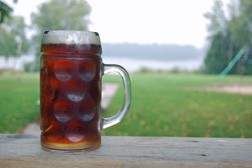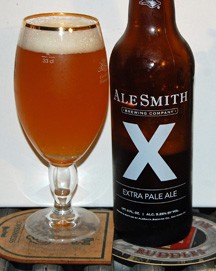O’zapft Is! (It’s tapped!)
- Share
- Tweet
- Pin
- Share
I love the fall, and not just because it means the end of obnoxious heat, humidity and flip-flops (hooray!). It’s a beautiful season and it means it’s time for one of the truly great seasonal beers, Oktoberfest!

When I saw an ad in the Pulse that Coyote Roadhouse had Spaten on tap, the original Oktoberfest from Munich, Germany, I suggested to my co-workers that we should have an Oktoberfest session.
The Spaten at Coyote Roadhouse is served in a half-liter German-style stein. The beer is a beautiful chestnut color. This is the export version of Oktoberfest, a traditionally low-hopped malty lager, possibly modeled after amber-colored Vienna lagers.
Oktoberfests served in Germany these days are golden-colored. I’ve had the golden versions, but they don’t do it for me. They look too much like regular, old lager, which I love, but in a different way from Oktoberfest. I will always prefer the amber-hued versions of this great lager style.
Spaten was the first brewery to make Oktoberfest, in 1872, if I recall correctly. The headline above this column – O’zapft is! (It’s tapped!) – is what the mayor of Munich says before opening the first keg of Spaten to officially start the annual Oktoberfest (Sept. 21 – Oct. 6 this year).
Spaten’s Oktoberfest is an absolutely delicious and beautifully balanced lager.
I followed that with a Wisconsin Oktoberfest, Staghorn from New Glarus Brewing. Wow, what a difference between it and the German original – fruity and aromatic. There is a lot going on in this beer from New Glarus. I’d forgotten what a great beer this is. Very different from the stately elegance of Spaten, but still a really good and exciting beer.
Since that day, I’ve also had Oktoberfests by Central Waters of Amherst (good) and Sprecher of Glendale (gorgeous), and I’ll be trying others as I find them.

* * *
Alesmith Extra Pale Ale is a very nice beer. Reminds me of the tasty English pale ales I grew up on – beautifully, rather than obnoxiously, hopped.
What? An American brewery that can make a subtle pale ale? It seems too good to be true.
And then I remembered a story I did way back in 2005, an interview with Alesmith founder Peter Zien, who got his start in an award-winning homebrew club in San Diego, Calif., called QUAFF (the Quality Ale and Fermentation Fraternity).
I talked to him about the club’s attention to detail shortly after QUAFF won its fifth consecutive Homebrew Club of the Year title from the American Homebrewers Association. Zien had served as club president from 1999 to 2001, the year QUAFF began its amazing national title run (the club went on to win six consecutive titles 2001-2006). In 2002, Zien began focusing on commercial brewing at his new business, AleSmith.
I’d let you know what he said about brewing great beer, but the company I worked for at the time owns the rights, so I’ll just say Zien and the QUAFF homebrewers believe in style definitions and they take pride in trying to emulate them. The Extra Pale Ale proves that.

